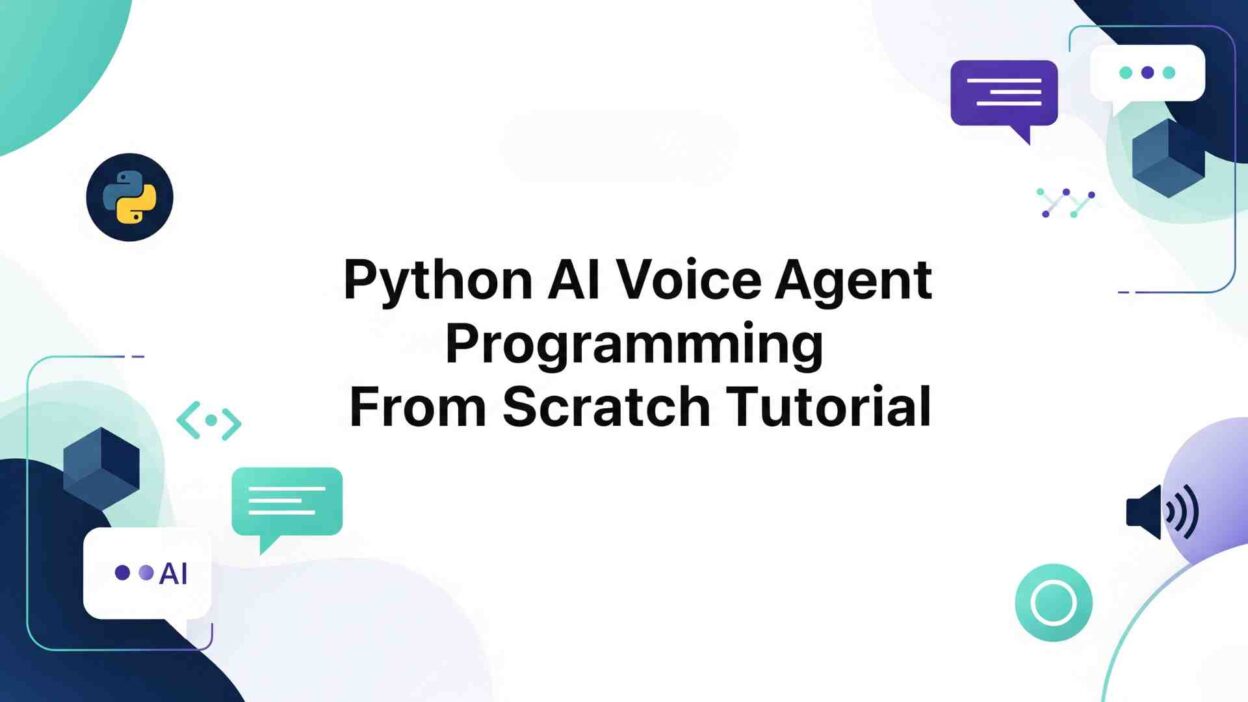TL;DR Python AI voice programming has revolutionized how developers create intelligent voice assistant development solutions for modern business applications. This comprehensive guide teaches everything needed to master voice assistant development, from basic concepts to advanced AI calling code implementation. Modern businesses require sophisticated Python AI voice programming skills to create competitive automation solutions that enhance customer experiences.
Table of Contents
Voice assistants have become essential tools for business automation and customer engagement across industries. AI calling code enables developers to create sophisticated communication systems that handle complex customer interactions automatically. This tutorial covers complete voice assistant development processes using industry-standard Python libraries and frameworks.
Python Fundamentals for Voice Assistant Development
Python serves as the perfect programming language for voice assistant development. Developers need solid Python fundamentals, diving into complex AI calling code projects. Python AI voice programming requires understanding variables, functions, loops, and conditional statements thoroughly.
Modern voice assistant development leverages Python’s powerful libraries for speech recognition, natural language processing, and audio manipulation. The language provides excellent integration capabilities with cloud services and third-party APIs. Python AI voice programming environments offer debugging tools and development frameworks that streamline voice application creation.
Essential Python Concepts
Variables and data types form the foundation of any voice assistant development project. Python AI voice programming uses strings for handling voice commands and responses effectively. Developers must understand how to manipulate text data for processing customer speech inputs.
Functions organize AI calling code into reusable components that handle specific voice processing tasks. Voice assistant development requires modular programming approaches for managing complex conversation flows. Python AI voice programming benefits from well-structured function designs that separate concerns clearly.
Python Data Structures for AI Calling Code
Data structures play crucial roles in voice assistant development for storing conversation history and managing user interactions. Lists and dictionaries enable efficient data organization for Python AI voice programming applications. Voice systems require fast data access for real-time conversation processing and response generation.
Conversation management relies heavily on proper data structure selection and implementation strategies. AI calling code uses dictionaries for storing user profiles and conversation contexts effectively. Python AI voice programming leverages lists for managing voice command sequences and response patterns.
Working with Voice Data
Voice data requires specialized handling techniques for optimal processing performance and accuracy. Python AI voice programming uses specific data structures for audio processing and speech recognition tasks. Voice assistant development systems store audio samples in byte arrays for efficient memory usage.
Text processing functions convert speech recognition results into structured data formats for analysis. AI calling code manipulates strings and lists to extract meaningful information from customer conversations. Python AI voice programming includes data validation techniques for ensuring voice input quality.
Advanced Python for Voice Assistant Development
Advanced Python concepts enable sophisticated voice assistant development with complex conversation management capabilities. Object-oriented programming principles help organize AI calling code into maintainable and scalable applications. Python AI voice programming benefits from class structures that encapsulate voice processing functionality.
Error handling becomes critical in voice assistant development for managing speech recognition failures and API timeouts. Exception handling ensures Python AI voice programming applications remain stable in the unexpected situations. Voice systems require robust error recovery mechanisms for maintaining customer satisfaction.
Asynchronous Programming
Modern voice assistant development requires programming for handling multiple customer conversations. Python’s async capabilities enable efficient resource utilization in AI calling code applications. Voice systems process multiple audio streams without blocking other operations or degrading performance.
Concurrent processing improves voice assistant development scalability for enterprise applications handling thousands of calls. Python AI voice programming uses asyncio libraries for managing simultaneous speech processing tasks. Real-time voice applications benefit from proper asynchronous implementation strategies.
Data Science with Python for Voice Analytics
Voice analytics provides valuable insights into customer behavior and conversation effectiveness for business optimization. Python AI voice programming includes machine learning libraries for analyzing speech patterns and customer sentiment. Voice assistant development systems generate comprehensive reports on interaction quality and success rates.
Statistical analysis helps improve AI calling code performance by identifying common conversation bottlenecks and failure points. Python AI voice programming leverages data science techniques for optimizing voice recognition accuracy. Voice systems benefit from continuous learning algorithms that adapt to customer speech patterns.
Machine Learning Integration
Machine learning enhances voice assistant development with predictive capabilities and intelligent response generation features. Python AI voice programming integrates popular ML libraries for natural language understanding and processing. Voice systems use trained models to improve conversation quality and customer satisfaction rates.
Custom model training enables voice assistant development teams to create industry-specific solutions with specialized vocabulary. AI calling code incorporates machine learning pipelines for continuous improvement and optimization. Python AI voice programming supports various ML frameworks for different voice processing requirements.
Web Development with Python for Voice APIs
Web frameworks enable voice assistant development teams to create scalable APIs and web interfaces for voice applications. Python AI voice programming uses Flask and Django for building voice service backends and management dashboards. Voice systems require web interfaces for configuration, monitoring, and analytics visualization.
REST API development connects voice assistant development applications with external services and business systems seamlessly. Python AI voice programming creates endpoints for handling voice requests and delivering responses efficiently. Web integration enables voice systems to access databases and third-party services automatically.
API Design Patterns
Effective API design ensures voice assistant development systems integrate smoothly with existing business applications and workflows. Python AI voice programming follows REST principles for creating maintainable and scalable voice service interfaces. Voice APIs require proper authentication and rate limiting for security and performance.
Documentation and testing frameworks help voice assistant development teams maintain high-quality API implementations. AI calling code includes comprehensive error handling and response formatting for consistent client experiences. Python AI voice programming APIs support various data formats and communication protocols.
Python Practice Projects for Voice Development
Hands-on practice projects accelerate voice assistant development, learning, and skill development for aspiring voice application developers. Python AI voice programming exercises range from simple voice recorders to complex conversational AI systems. Practice projects help developers understand real-world challenges in voice system implementation.
Building progressively complex voice applications strengthens Python AI voice programming skills and confidence levels. Voice assistant development practice includes working with different audio formats and speech recognition services. Developers benefit from implementing various voice processing techniques and comparing their effectiveness.
Voice Assistant Programming Tutorial
Step 1: Install Required Libraries
Voice assistant development begins with installing essential Python libraries for speech recognition and audio processing capabilities. AI speech models in Python requires several specialized packages for handling speech input and output operations. The installation process includes speech recognition, text-to-speech, and audio manipulation libraries.
In Python, the SpeechRecognition module helps us do this by capturing audio and converting it to text. Modern voice systems require additional libraries for enhanced functionality and integration options. Pip:
install –
SpeechRecognition
pyttsx3
pyaudio
openai
requests
These libraries provide the foundation for AI calling code development with comprehensive voice processing capabilities. Voice assistant development projects typically require additional packages based on specific feature requirements. AI speech models in Python environments should include all necessary dependencies for smooth development workflows.
Step 2: Import All Necessary Modules
Python AI voice programming applications begin by importing required modules for speech processing and AI integration. Voice assistant development code organization starts with proper module imports and configuration settings. Import statements define the available functionality for AI calling code implementation. Import:
speech_recognition as sr
pyttsx3
openai
threading
time
json
Module imports enable access to speech recognition, text-to-speech conversion, and AI language model capabilities. Voice assistant development requires careful module selection for optimal performance and functionality. AI speech models in Python projects benefit from organized import structures and clear dependency management.
Step 3: Initialize the Speech Engine
Voice assistant development requires proper speech engine initialization for text-to-speech functionality and voice output capabilities. AI speech models in Python uses the pyttsx3 library for converting text responses into natural-sounding speech. The speech engine configuration affects voice quality, speed, and personality characteristics.
engine = pyttsx3.init()
voices = engine.getProperty(‘voices’)
engine.setProperty(‘voice’, voices[0].id)
engine.setProperty(‘rate’, 150)
Speech engine settings customize voice characteristics for specific business requirements and user preferences. AI calling code includes voice selection options for male or female voices based on brand preferences. AI speech models in Python allows dynamic speech property adjustments in the runtime for personalized experiences.
Step 4: Wish the User
Voice assistant development includes greeting functionality that creates positive first impressions and establishes conversation context. AI speech models in Python systems generate personalized greetings based on time of day and user information. Welcome messages set the tone for successful customer interactions and engagement.
def greet_user():
hour = datetime.now().hour
if hour < 12:
greeting = “Good morning! How can I assist you today?”
elif hour < 18:
greeting = “Good afternoon! How may I help you?”
else:
greeting = “Good evening! What can I do for you?”
engine.say(greeting)
engine.runAndWait()
Greeting functions demonstrate voice assistant development best practices for creating engaging user experiences. AI calling code includes contextual awareness for delivering appropriate messages based on interaction timing. AI speech models in Python systems adapt greetings based on user history and preferences automatically.
Step 5: Simulate User Voice Command Processing
Voice assistant development requires robust speech recognition capabilities for accurately capturing and processing user voice commands. AI speech models in Python systems handle various audio quality conditions and speaking styles effectively. Voice recognition accuracy directly impacts system performance and user satisfaction levels.
def listen_for_command():
recognizer = sr.Recognizer()
microphone = sr.Microphone()
with microphone as source:
recognizer.adjust_for_ambient_noise(source)
print(“Listening for command…”)
audio = recognizer.listen(source, timeout=5)
try:
command = recognizer.recognize_google(audio)
print(f”User said: {command}”)
return command.lower()
except sr.UnknownValueError:
return “Could not understand audio”
except sr.RequestError:
return “Recognition service unavailable”
Speech recognition functions form the core of AI calling code applications for processing customer input accurately. Voice assistant development includes error handling for recognition failures and network issues. Python NLP for voice systems provide fallback mechanisms for maintaining conversation flow in the technical difficulties.
Step 6: Main Assistant Function
The main assistant function orchestrates voice assistant development workflows by coordinating speech recognition, processing, and response generation. Python NLP for speech applications use central control functions for managing conversation states and business logic. AI calling code requires sophisticated flow control for handling various customer scenarios and requests.
Creating a Python-based AI voice assistant is easier, thanks to powerful libraries, SpeechRecognition, pyttsx3, and OpenAI. Modern voice systems integrate multiple AI services for comprehensive functionality.
def main_assistant():
greet_user()
True:
command = listen_for_command()
“exit” in command or “goodbye” in command:
engine.say(“Goodbye! Have a great day!”)
engine.runAndWait()
break
response = process_command(command)
engine.say(response)
engine.runAndWait()
Main control functions demonstrate voice assistant development architecture for scalable and maintainable applications. Python AI voice programming includes loop structures for continuous conversation management. AI calling code systems require proper session management for handling multiple customer interactions.
Step 7: Run the Assistant and Business Integration
Voice assistant development deployment requires proper execution workflows and integration with business systems for practical applications. Python NLP for voice applications need startup procedures that initialize all required components and connections. Production systems include monitoring and logging capabilities for performance tracking and troubleshooting.
PreCallAI demonstrates how voice assistant development integrates with business processes for automated customer outreach and qualification. AI calling code connects with CRM systems and databases for personalized customer interactions. Python NLP for voice enables sophisticated business automation that improves sales efficiency and customer satisfaction.
__name__ == “__main__”:
print(“Starting AI Voice Assistant…”)
main_assistant()
Execution control ensures voice assistant development applications start properly and handle initialization errors gracefully. Python NLP for voice includes configuration loading and system checks, beginning voice operations. Production AI calling code systems implement comprehensive startup validation and health checking procedures.
Advanced Features for Production Voice Assistant Development
Real-Time Conversation Management
AI voice assistants are rapidly transforming how businesses handle customer interactions. Production voice assistant development requires sophisticated conversation management for handling complex customer interactions and business scenarios.
Machine learning voice recognition applications maintain conversation context across multiple dialogue turns and topic changes. Voice systems track customer information and preferences for personalized interaction experiences. AI calling code includes conversation history analysis for improving response quality and relevance.
Integration with Business Systems
Voice assistant development reaches its full potential, integrated with existing business applications and workflows. Machine learning voice recognition connects with CRM platforms, helpdesk systems, and customer databases. AI calling code synchronizes customer interactions with business records for comprehensive relationship management.
Learn how to build a conversational AI voice assistant with Twilio Voice and the OpenAI Realtime API using Python and the FastAPI framework. Modern voice systems leverage cloud services for scalability and reliability.
Performance Optimization and Scalability
Production voice assistant development requires optimization techniques for handling high call volumes and maintaining response quality. machine learning voice recognition includes caching strategies and resource management for efficient operations. AI calling code systems implement load balancing and auto-scaling for peak demand periods.
Voice applications benefit from asynchronous processing and parallel conversation handling for improved throughput. machine learning voice recognition uses threading and multiprocessing for concurrent speech processing tasks. Performance monitoring helps identify bottlenecks and optimization opportunities in voice assistant development projects.
Read More: Microsoft Teams AI Calling Features Transform Remote Work
Thank You!

This comprehensive Python voice input handler tutorial provides the foundation for creating professional voice assistant development applications. The step-by-step approach covers everything from basic setup to advanced business integration techniques. AI calling code skills enable developers to create valuable automation solutions that transform customer experiences.
Voice assistant development continues evolving with new technologies and capabilities that expand automation possibilities. Python voice input handler offers unlimited potential for businesses seeking competitive advantages through intelligent customer engagement. PreCallAI exemplifies how modern voice automation creates meaningful business value through sophisticated conversation management.
The future belongs to developers who master Python voice input handler for creating next-generation business communication systems. Voice assistant development skills become increasingly valuable as organizations recognize AI calling code potential for growth and efficiency. Start building your voice applications today and transform how businesses connect with customers worldwide.






[…] Read More: Python AI Voice Agent Programming From Scratch Tutorial […]
[…] Read More: Python AI Voice Agent Programming From Scratch Tutorial […]